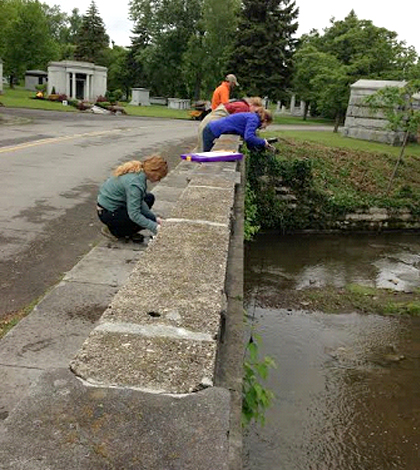Scientists Find Buffalo’s Scajaquada Creek Gets Most Nutrients From Runoff

Until it peeks its headwaters out of the ground, most of Scajaquada Creek flows underneath the City of Buffalo, making its home in some three-and-a-half miles of pipe. From there it flows past Forest Lawn Cemetery on its way to the Blackrock Canal and ultimately drains into Lake Erie.
With encouragement from the cemetery, the Buffalo Niagara Riverkeeper asked scientists at the University at Buffalo and New Mexico Institute of Mining and Technology to look into the creek’s hydrology as it comes above ground. The investigation covered a one-and-a-half mile stretch, with scientists zeroing in on a sewer outflow pipe and runoff from the cemetery.
“We tested E. Coli levels in the summer, fall and winter,” said Susan Little, graduate student of hydrology at New Mexico Tech. She and others from the Riverkeeper and U. Buffalo sampled the area over a course of 18 months with a Hach Turbidimeter and YSI multiprobe that helped collect data on water quality parameters like pH, temperature, conductivity and total dissolved solids.
The investigation into E. Coli concentrations was carried out near the outflow pipe, and the results weren’t that surprising.
“The E. coli was of a lot of interest because the CSO (combined sewer overflow) pipe is right there,” said Little. “Combined with the back pressure of the creek itself, we saw high E. coli concentrations at the pipe that decreased linearly with distance.”
Essentially, E. coli concentrations were found to be lower at distances farther away from the pipe. For conductivity, a measure that Little says is indicative of road salt application in the area, levels were low at the outflow pipe but went up as researchers moved downstream.

But scientists found very different results when they considered nitrates and phosphates along the same length of Scajaquada Creek. This part of investigating the stream’s water quality relied on fieldwork and lab analysis.
“We saw a series of spikes with nitrates and phosphates that correlated with outflow pipes of the cemetery,” said Little. “It would sort of decrease and then there’d be a pipe and it would increase again.”
The most likely culprit for the nitrogen and phosphorous concentrations is runoff, Little says, and she hopes the findings will help the cemetery better manage its contributions to the creek’s health. The Riverkeeper has also gotten an update on the creek and can use the data in larger-scale restoration efforts.
High phosphorus downstream was unexpected because researchers thought most of the nutrients were coming from the outflow pipe, Little says. To find that the levels were caused by human inputs instead was a surprise.
“The idea for so long with the CSOs that drain into Lake Erie was that the solution to pollution is dilution. We’re disproving that to a degree,” said Little. “With all the algal blooms we’ve seen, one way to deal with that is to deal with these streams.”
Top image: Researchers use a YSI handheld meter to take measurements of water quality. (Credit: Chris Murawski / Buffalo Niagara Riverkeeper)




0 comments